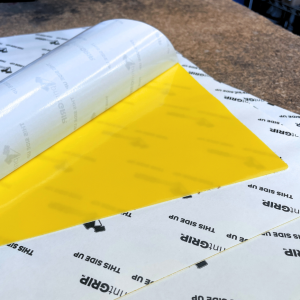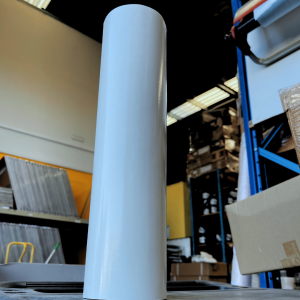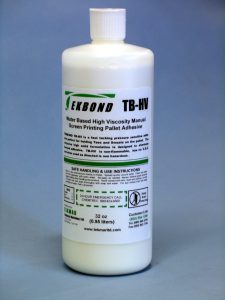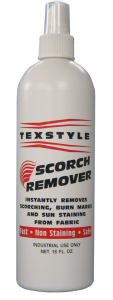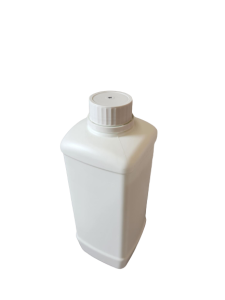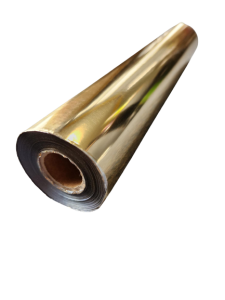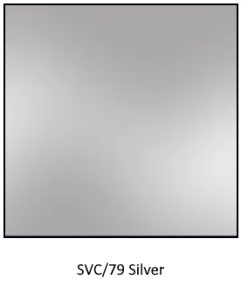Getting to know Sam, co-owner of Ministry of Shirts
This month, we’re thrilled to spotlight the remarkable story the co-owners of The Ministry of Shirts, Sam and his daughter, Lydia, whose dynamic partnership has woven a tapestry of success in the Australian screenprinting industry.
Like many in the craft, Sam and Lydia’s odyssey began in the humble confines of a garage. However, what sets Ministry of Shirts apart is the powerful father-daughter duo at its helm, a combination that has proven to be the secret ingredient in their recipe for triumph. Their tale is a testament to the adage that great things often have small beginnings, as they’ve rapidly outgrown each successive workspace, evolving from the classic “blue press” to the sleek, red Anatol automatic press that now anchors their operations.
Sam and Lydia’s journey is nothing short of extraordinary – a narrative of reinvention and resurgence that has seen him transition from retirement to becoming a staple name in the Australian screenprinting scene. It’s a story that embodies the spirit of entrepreneurship and the power of family collaboration.

About Sam
List 3 things about yourself – fun facts, hobbies, pets or interests
- I sold up and retired from business in 2017, then took up screenprinting with my daughter as a hobby! What was I thinking!
- I had a semi-pro interest in painting landscapes in watercolour and oils. Thought I could make it as an artist at one point – turns out I was wrong but still love to paint as a way of relaxing at weekends when I get the time!
- I co-host a screenprinting podcast (The Aussie Screen Printer’s Club) with a screenprinting mate. The show is aimed at stimulating conversation in the market in Australia. We all suffer from the tyranny of time and distance in Australia, so we hope it brings people closer together to share and swap stories and ideas.
Describe your screen printing journey. How and when did you get started and what has been your biggest learning experience?
Biggest learning experiences for me were two-fold. Firstly, understanding how screenprinting works. I don’t just mean how to pull a squeegee or do colour separations; I mean understanding how all the processes and variables work together. You can spend a lot of time trying to fix or make things better by looking at the wrong end of the process and making big stupid changes.
Growing in my understanding of the variables of the print cycle from ‘cradle to grave’ was when things started to click for me. It took a long while, and of course I am learning new stuff all the time, but it did require a lot of patience to get to where we are. Secondly, I think understanding the business end of things took a while. It’s the first time I have properly run a business in manufacturing. I owned a Publishing Company in the UK and we would send books to press but I had next to nothing to do with the print and binding production.
In the Ministry of Shirts it took me a while to understand how production (all those variables again!) need to be placed in a system that links the front end of the business (specifically sales, marketing, purchasing and customer service) to the backend in production in a way that makes the process line less clunky. We tried a few different things before we started to oil the overall machine well enough to be able to crank the handle to get the volume up. It’s not all about purchasing an auto, there is so much more to it than that.
Bigger ovens, more staff, more automation of other processes, more screens…then taking that and connecting it to the in-flow of new orders in a way that does not slow production or clog-up the pipeline was hard at first. We continue to learn and refine those processes but are happy with the way things are working now – most of the time!
Tell us about your proudest screen printing project. What made it special and what did you learn from it?
I think the best thing is when you get some solid positive feedback from customers. That brings the most joy in this job. Sure, we are doing this to earn a wage, but we also do it for the customers and getting that feedback is awesome. We have a WhatsApp group for the whole team called shop talk and share all the stories we get from our customers on there so that the whole team get to enjoy that together.
Of course, the other thing I think I am proud of is my daughter Lydia taking on the running of the production from film output right through to putting boxes on a truck. From the age of 19 She has run the team and makes it work smoothly. As a parent working with your child that’s a great joy!
The other thing I am proud of is the team we have at the moment. They are the nicest bunch of people ever and work so hard and go beyond the pale when required. We start the day with a ‘drains up’ stand-up meeting and sometimes people bring in show-n-tells, it’s a lot of fun, and it’s all mostly down to them. We love them!

Industry
What are your thoughts on the current trends in screen printing? Do you see any emerging styles or techniques that excite you?
There are some technologies emerging now around CTS solutions – like laser – that I think will breakthrough into the mainstream screen print market on cost and quality eventually. One that we are keeping a watching brief on is the D2M Rapid Screen system. It’s a Swiss/Aussie solution that coats the screen with just the stencil and exposes it at the same time. The results and longevity of the prints seem to be outstanding.
For those that are unaware of it there is a bit of a mind-shift required to get your head around it a little – at least that’s the way it was for me. Basically, the unit lays down the emulsion directly onto the screen and leaves the stencil component (i.e. the area we want the ink to pass through) off the screen. What’s good about it is you can cut out a ton of processes by using it. No film, no emulsion coating, no burning or washing out the stencil. The screens can go from the unit straight to the press!
The only wet process required is cleanout of ink and then reclaiming where you ‘simply’ blow out the emulsion with a pressure washer, no need to dump it in a dip tank! You can build up thicker stencils easily as required too. I am keen to see it in practice and checkout the pricing, but it looks good!
What role does the online community play in your screen printing practice? How do you connect with other printers and share knowledge?
As mentioned above the podcast helps us to connect to screen printers and find out what’s going on, but it’s not enough! As well as in Australia I connect a lot online with other printers in the USA and the UK but wish we had more time to develop those relationships.
There is no doubt that we are in an industry that’s open to dialogue and sharing ideas but I can’t help feeling we would benefit more from developing some sort of apparel decoration group here in Australia where we can have some small conference like events to meet more folks and share more about what we do and what’s trending etc.
I suspect, like me (!), a lot of printer’s don’t have the time to lend to organising it; but it would be good. Some other great podcasts that I assume most people know about would be ‘The Chippie Tee Podcast’; ‘Print Hustlers Podcast’; ‘Success stories with Marshall Atkinson’; and of course ‘the Shirt Show’. We have gleaned heaps of advice and technical know-how from these over the years.

Shop Floor
What your most treasured product or piece of equipment on the floor that has made your life easier as a printer? Why?
I guess this depends on what stage we were at when we purchased the equipment. When we moved from manual to auto-presses that would have been the best change ever. The freedom to print without you arms falling off and so much quicker than ever before made our lives so much better and allowed us to cope with growth in a less scary way.
But more recently our purchase of the emulsion coater (the Aussie made ADCO Teecoat and outstanding product with so much control, highly recommend) was a biggie as it meant anyone could take a look at the standard operating procedure and coat screens with exactly the same consistency each time. Basically, it means I no longer have to coat screens! Our ink mixer along with our (Shurloc) squeegee cleaner are treasures too!
What is on your wish list for your shop floor this year?
Ok, so this is tricky for us as we are moving to newly built premises in the next months (hopefully!), so that’s a big expense for us with a full kit out for stock room, offices, screen storage, pre-press, drying rooms, an ink kitchen and a wet room.
But if I had a crystal ball, I would say both a third press and also CTS (possibly Wax with the Exile Spyder II or this new one I mentioned above) is where we should go. We will need to see if budgets allow though as we are reaching some dizzy heights there that are easy to fall from!

Advice
What advice would you give to aspiring screen printers? What are the essential skills and qualities for success in this field?
I don’t feel that qualified to answer this as our entry into the industry has been haphazard at one extreme and just good providence at the other extreme. That said I would proffer a few tips that might help as follows:
I don’t feel that qualified to answer this as our entry into the industry has been haphazard at one extreme and just good providence at the other extreme. That said I would proffer a few tips that might help as follows:
1. Learn the screenprinting craft thoroughly. Immerse yourself in it from understanding everything from mesh counts, to different emulsions, different light spectrums, different squeegee durometers, become a screen-print-savvy nerd! You wont regret it!
2. Learn the artwork side thoroughly. You don’t need to be a graphic designer but learning to choke, trap, separate, and halftone your way onto a screen is essential to getting a good print – no matter how good you are at screenprinting. This may be something you outsource to others later, but grasping how it works now will help you heaps on the press. I have a slight disdain for Photoshop to produce films in our industry and would recommend migration to Illustrator as a good thing, but that said many people produce amazing work on Photoshop too.
3. Learn how business works. Get some books, from branding to marketing. Find some business courses to attend that teach you to close deals. I can’t stress this enough. It seems to me this is most screen printers (just like artists!) Achilles heel. I think a lot of screen printers get so far in their business but then plateau in growth. Business is a hard thing to learn but it’s not impossible.
Learn how to create a strategy for your business, learn how to ignore your account safely (those two are related!). Learn how to develop a team and grow the business to where you want it. This all needs so much more planning than people realise as it never happens by accident. I am not saying I know how to do all these things as every day there are new business challenges but creating a pathway to the future that succeeds rather than a pathway to paralysis is essential.
Find a business friend. Maybe even in a different industry and go for a pint now and again to chew the fat and talk about the struggles of growing business.
4. Lastly, learn from your mistakes and don’t let them define your success or failures! The first two years of business are the most perilous and sometimes I think if we just keep-on with the keeping-on it really does help. Don’t give up!

Bonus
What’s your go-to playlist for a productive printing session?
For me this question is easy. If I get to do any printing, I like to listen to some independent guitar bands from the 80’s and 90’s which is my era! The Smiths, Echo and the Bunnymen, Lloyd Cole and the Commotions, Joy Division, The Cure (early stuff!) they would all be on my list. Saying that I would equally enjoy listening to some Sibelius but probably would need to put the air pods in for that!
Conclusion
Sam and Lydia have built a business that started out as a hobby. This is one of those stories that serves as inspiration for those who are currently in a hobby and would like to pursue it further as a business and a career. Sam and Lydia’s story is nothing short of inspiring, having built and established a solid business in 8 years which is growing each year.
The duo have built an amazing team that whips out prints on the daily. From printing a love job to printing for businesses, organizations and brands, a true grass roots business in Australia.
Written by the Jones Brothers Printechnology Team in collaboration with Sam Austrin-Miner, co-owner of Ministry of Shirts.






